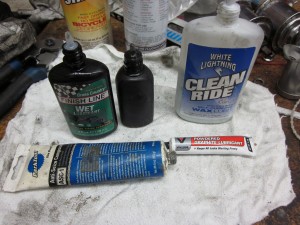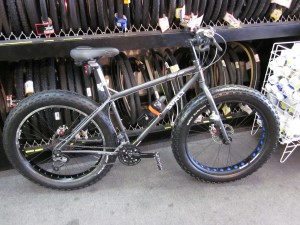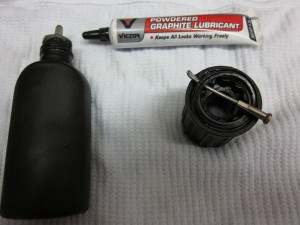Riding in extreme weather conditions can be challenging. You may have to get creative and make some compromises. That new 10 speed cassette is probably too finicky (not to mention pricey) to do winter work. Ask around for suggestions. Foresight and preparation is preferable to having to fix a flat or worse at 0 deg in the middle of nowhere. Things can go wrong even after preparing for what you might think are all possible problems. But not all potential problems are equal. And the point is to minimize the risk of especially catastrophic failures by planning for as many of them as is reasonably possible… Being aware of your bikes condition and replacing dangerously worn parts is especially necessary if you plan on riding in less populated areas. If you choose to ride bulging tire sidewalls, fatigued, rusted spokes you really are taking chances. It may be time to replace that rusty chain/cassette or that fifteen year old radially laced hub.
Cold
For cold weather riding, using studded tires, quality cables, full housing lengths and light, bike-specific lubes (or inexpensive alternatives such as graphite and mineral oil) can keep your bike working in sub-zero conditions. Being aware of changing weather conditions and lubing drive train etc. frequently can help keep rust away when contending with water, salt and grit. Your particular riding  conditions will dictate what you might need to survive the cold but the simplicity of a single speed or fixed gear (generally for less hilly terrain), disc brakes- or just a designated winter bike- can help. Mixing mineral oil and marine grease makes a cheap yet effective cable lube which is less affected by low temperatures. Mineral oil or ATF fluid can be added to multi speed hubs to help keep pawls moving. The initial investment in a set of studded tires can be weighed against the danger of falling and can often be used for years and years.
conditions will dictate what you might need to survive the cold but the simplicity of a single speed or fixed gear (generally for less hilly terrain), disc brakes- or just a designated winter bike- can help. Mixing mineral oil and marine grease makes a cheap yet effective cable lube which is less affected by low temperatures. Mineral oil or ATF fluid can be added to multi speed hubs to help keep pawls moving. The initial investment in a set of studded tires can be weighed against the danger of falling and can often be used for years and years.
Besides prohibiting corrosion, many lubes inside cables, shifters (in pawls), cassette/fw bodies will become sticky, attract dirt (cables esp) and present problems generally when cold. De-greasing pawls in shifters completely and re-lubing with a light lube (mineral oil, graphite, or a lighter,  drier lube) can keep things moving. Sealed ferrules can be useful at a derailleur stop to keep water out and lubes in- but may cause added friction from the cold seals themselves. A 9 speed reverse-pull derailleur may just be too finicky for reliable winter indexing. Using a 7/8 speed cassette or friction shifter may be needed or preferred. Although some riders like a narrower tire to “cut” through the snow, a wider mountain tire (preferably studded) really may be a better all around choice by adding a bit of cushion for the near off road terrain created on many paths and roads by freezing slush. It also helps pad what you can’t see under a blanket of snow. Or just get a Surly Moonlander if you want to take this idea to the extreme.
drier lube) can keep things moving. Sealed ferrules can be useful at a derailleur stop to keep water out and lubes in- but may cause added friction from the cold seals themselves. A 9 speed reverse-pull derailleur may just be too finicky for reliable winter indexing. Using a 7/8 speed cassette or friction shifter may be needed or preferred. Although some riders like a narrower tire to “cut” through the snow, a wider mountain tire (preferably studded) really may be a better all around choice by adding a bit of cushion for the near off road terrain created on many paths and roads by freezing slush. It also helps pad what you can’t see under a blanket of snow. Or just get a Surly Moonlander if you want to take this idea to the extreme.
A studded tire Mt bike with ABS zip-tied “clip on” plastic fenders (the ones with stays tend to break by bouncing into tire knobs), coupled with friction shifter, full lengths of housing and a larger 13t tooth 7 spd cassette might just be a great set-up for you too!
 Cassette bodies and freewheels are especially prone to skipping (or worse: front freewheeling) when below freezing. Some higher end hubs may be less prone to water infiltration, but simply using a lighter lube in the cassette body usually does the trick (i.e. Mineral oil or T9 with added graphite). A mineral oil/ grease mix can also be injected using a grease gun and a small length of housing-liner flattened on one end.
Cassette bodies and freewheels are especially prone to skipping (or worse: front freewheeling) when below freezing. Some higher end hubs may be less prone to water infiltration, but simply using a lighter lube in the cassette body usually does the trick (i.e. Mineral oil or T9 with added graphite). A mineral oil/ grease mix can also be injected using a grease gun and a small length of housing-liner flattened on one end.
Shimano at one time made what I believe was called the Deore XT “mud rake”. Designed to scrape away “mud” from the high (small) cogs on an 11t cassette, it did a reasonable job of scraping snow as well. That is until the plastic teeth on the rake/ comb inevitably broke. Never fear however, it was possible to fix with a custom made metal rake or simply make a complete one from scratch.
Multi speed hubs can often get fouled up/ skip for the reasons stated above. Lube accordingly. The Nuvinci seems a promising winter internal cantidate and is rated to operate in up to -5 deg F. Downside: There are still the standard pawls in the freewheeling unit which may present problems and like many internals, the cables may present problems if you can’t remove the wheel without first disconnecting them.
Keeping your snowy bike outside if possible (a garage etc) can keep snow from repeatedly melting and potentially getting into things. Lubing often, especially after an extremely slushy ride home is a must.
Note: Bicycle repair in sub-freezing weather should really be avoided at all costs. Once your hands are outside of gloves/ mittens for any length of time they can become useless or worse. Although flats may not be as common with a thick blanket of snow and tires which are rock hard, tubes become a bit more brittle. Making sure you have a wide enough tube for your tire (i.e. not overly stretched), using a quality rim strip (cloth: which covers around valve hole) and de-burring” the valve hole in the rim and using valve caps can all decrease the chance of tube failure. Tires with high puncture resistance or tire strips when used correctly can help (see “Tires” section for info on removing sharp edges from “Mr Tuffy” type strips- if left unfinished they can lead to flats- especially in cold weather)
Heat
In places where thorns are a big problem, tire strips, an old tire tread inside of a tire (minus bead/ sidewall), “slime” or solid tires may be the only practical solutions. Enough water, cell phone and telling folks where you are will help if you get stranded.
Clothing
Clothing choices are a bit subjective. Checking the weather these days is probably a given but for those longer trips, especially when the weather is around freezing, be prepared. Temperatures can drop quickly as new fronts move in. Freezing rain can turn an otherwise suitable amount of clothing into a near useless mop. Layering is usually a good idea. A nice waterproof shell (or at least water resistant one) can really be a life saver. Although extreme activity can help warm you up it can also make you cold from added perspiration. Gloves may have to be mittens, bike shoes may have to be boots, nylon may have to be wool.
For warm weather: don’t get sun burned.

